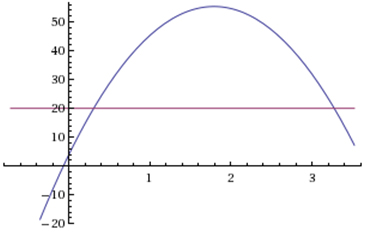
Now, let's look at a few more examples using our same equation, h(t) = -16t2 + 57.3t + 4.
What does it mean to take this equation and set it equal to a certain number (like 20.0) and then solve the equation? In other words, if you solve the equation: 20.0 = -16t2 + 57.3t + 4, what will your solution in terms of t actually mean?
If it is helpful to you, here is a graph of the functions h(t) = -16t2 + 57.3t + 4 and h(t) = 20.0.


Go ahead and solve this equation: 20.0 = -16t2 + 57.3t + 4. Again, if you don’t have your graphing calculator handy,  click here to access a website that will generate roots for a quadratic function.
click here to access a website that will generate roots for a quadratic function.
If you are using the website, you will need to set your equation equal to zero by subtracting 20 from each side. You may then use the website to solve the following equation: 0 = -16t2 + 57.3t - 16. What are your two solutions?
Interpret the meaning of the solution t ≈ 0.31

Now interpret the meaning of the solution t ≈ 3.28